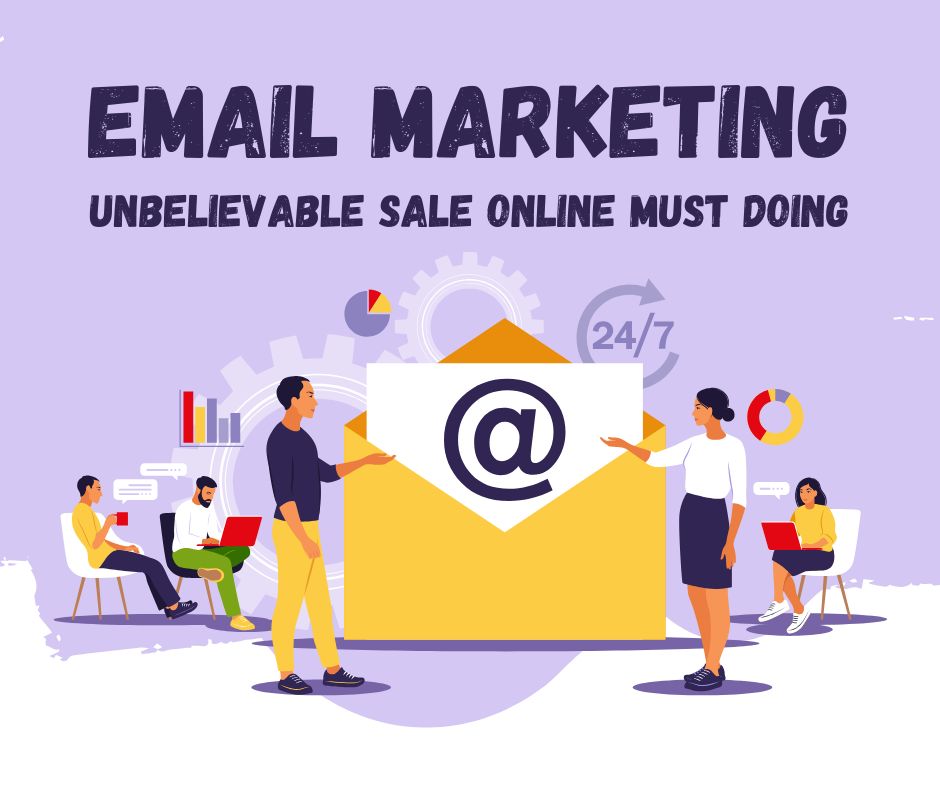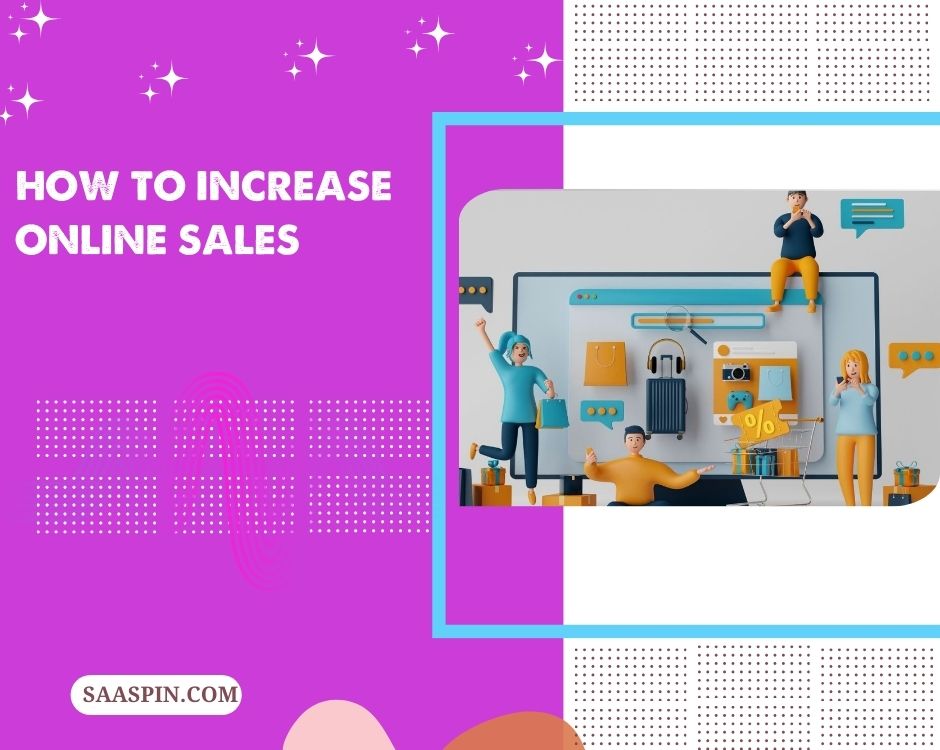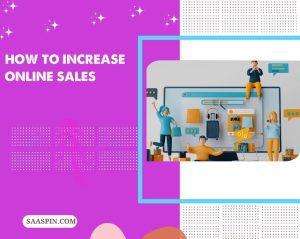To increase online sales, optimize your website for user experience and implement effective digital marketing strategies. Utilize social media and email marketing to reach a broader audience.
Increasing online sales is crucial for the success of any e-commerce business. Start by optimizing your website to ensure a seamless user experience. A user-friendly website can significantly reduce bounce rates and increase conversions. Digital marketing, including social media and email campaigns, can drive more traffic to your site.
These strategies help in building a loyal customer base and boosting sales. High-quality product descriptions and clear calls-to-action also play vital roles. Implementing these tactics can create a robust online presence, making it easier for customers to find and purchase your products.
Understanding Your Target Audience
Boosting online sales requires a strategic approach. One of the key online sales growth strategies is understanding your target audience. Knowing who your customers are helps tailor your marketing efforts, making it easier to increase online sales. Here’s how you can get to know your target audience better and use that knowledge to drive sales.
Identify Demographics
Start by identifying the demographics of your target audience. This includes age, gender, location, income level, and occupation. Use Google Analytics and social media insights to gather this information.
Demographic | Data Source |
|---|---|
Age | Google Analytics |
Gender | Facebook Insights |
Location | Instagram Insights |
Understand Psychographics
Psychographics delve deeper into your audience’s interests, hobbies, and values. Conduct surveys, interviews, and focus groups to gather this data. Tools like SurveyMonkey can be useful.
Interests
Hobbies
Values
Analyze Customer Behavior
Analyzing customer behavior helps you understand how they interact with your site. Use tools like Hotjar to track clicks, scrolls, and other interactions. This data provides insights into what works and what doesn’t.
Create Customer Personas
Combine the demographic, psychographic, and behavioral data to create detailed customer personas. These personas represent your ideal customers. They guide your marketing efforts and product development.
Research and gather data
Identify key characteristics
Create detailed profiles
Segment Your Audience
Segment your audience based on shared characteristics. This allows for more personalized marketing strategies. Use tools like Mailchimp for email segmentation.
Age groups
Geographic location
Purchase behavior
By understanding your target audience, you can implement effective online sales growth strategies. This knowledge helps you increase online sales and build stronger customer relationships.

Optimizing Your Website For Conversions
Increasing online sales is a goal for every e-commerce business. Optimizing your website for conversions is crucial to achieving this. A well-optimized site ensures visitors can find what they need quickly and easily. This translates to higher sales. Here’s how you can optimize your website for better conversions.
User-friendly Design:
A user-friendly design is key to keeping visitors engaged. Ensure your website is easy to navigate. Make menus clear and straightforward. Use a consistent layout throughout your site. This helps users find what they’re looking for quickly.
Clear Navigation: Use simple and intuitive menus.
Responsive Design: Ensure your site looks good on all devices.
Readable Fonts: Choose fonts that are easy to read.
Consistent Layout: Maintain a uniform look across all pages.
A user-friendly design can boost e-commerce sales. It makes the shopping experience enjoyable. Happy customers are more likely to make a purchase. Pay attention to every detail. Even small changes can make a big difference.
Loading Speed
Loading speed is crucial for keeping visitors on your site. A fast website improves the user experience. Slow-loading pages frustrate visitors. They may leave before your site loads.
Here are some benefits of fast-loading websites:
Reduced Bounce Rate: Visitors stay longer on fast sites.
Higher Conversion Rates: Faster sites lead to more sales.
Better SEO: Search engines favor fast websites.
Optimize images and use a content delivery network (CDN). Minimize HTTP requests. These actions improve your site’s speed. Regularly test your site’s performance. Make adjustments as needed to keep it running smoothly.
Clear Call-to-actions (ctas)
Clear call-to-actions (CTAs) guide visitors towards making a purchase. Effective CTAs are easy to spot and understand. They should be placed strategically throughout your site.
Here are some effective call-to-action examples:
Buy Now: Encourages immediate purchase.
Sign Up: Prompts users to create an account.
Learn More: Directs users to additional information.
Add to Cart: Simplifies the shopping process.
Use contrasting colors for your CTAs. This makes them stand out. Use action-oriented language. Keep the message short and to the point. Clear CTAs can significantly boost e-commerce sales.
Trust Signals:
Trust signals help build customer confidence. They reassure visitors that your site is safe and reliable. Trust signals can take many forms.
Here are some examples:
Customer Reviews: Display positive feedback from satisfied customers.
Security Badges: Show that your site is secure.
Money-Back Guarantee: Offer a risk-free purchase option.
Contact Information: Provide easy access to customer support.
Trust signals can make a big difference in boosting e-commerce sales. They help reduce any fears customers may have. Include trust signals on your product pages. This helps in optimizing product pages for sales.
Using Seo And Content Marketing To Attract More Traffic
Increasing online sales can be a challenge, but using SEO and content marketing to attract more traffic can help. These strategies can drive more visitors to your site and turn them into paying customers. Let’s delve into the fundamentals of SEO and content marketing to boost your digital presence.
Seo Fundamentals
Search Engine Optimization (SEO) is key to increasing your online sales. By optimizing your website, you make it easier for search engines to find you. Here are some E-commerce SEO tips:
Keyword Research: Identify the keywords your customers use. Tools like Google Keyword Planner can help.
On-Page SEO: Optimize your web pages with targeted keywords. Ensure they are in the titles, headers, and content.
Meta Descriptions: Write compelling meta descriptions. These appear in search results and can increase click-through rates.
Mobile Optimization: Ensure your site is mobile-friendly. Many users shop on their phones.
Page Speed: Improve your site’s loading speed. Faster pages reduce bounce rates and improve user experience.
Here’s a quick reference table for essential SEO elements:
SEO Element | Best Practices |
|---|---|
Title Tags | Include primary keywords, keep under 60 characters |
Header Tags | Use H1 for titles, H2 for subheadings, and H3 for sections |
Alt Text | Describe images with keywords |
By following these SEO fundamentals, you can improve your search engine rankings and attract more traffic, ultimately boosting your online sales.
Content Marketing
Content marketing is another powerful tool for increasing online sales. By creating valuable content, you can attract and engage your audience. Here are some effective content marketing strategies:
Blog Posts: Write informative blog posts. Share tips, guides, and industry news related to your products.
Product Descriptions: Craft detailed and persuasive product descriptions. Highlight benefits and features.
Social Media: Share your content on social media platforms. Engage with your audience and drive traffic to your site.
Email Marketing: Send newsletters with valuable content. Include special offers and updates.
Video Content: Create engaging videos. Demonstrate your products and share customer testimonials.
Here’s how to structure your content marketing efforts:
Content Type | Purpose | Frequency |
|---|---|---|
Blog Posts | Inform and educate | Weekly |
Social Media Posts | Engage and drive traffic | Daily |
Email Newsletters | Retain customers | Bi-weekly |
Videos | Demonstrate products | Monthly |
By implementing these content marketing strategies, you can attract more traffic to your site and increase your online sales. Remember, the key to digital marketing for online sales is consistency and quality.
Must Active On Social Media
Increasing online sales requires strategic efforts. One powerful way is to stay active on social media. Social media platforms help you reach a large audience quickly. They also allow for personal interaction with potential customers. Engaging your audience on social media can significantly drive traffic to your e-commerce site.

Connect Your Online Store To Social Media Accounts
Connecting your online store to social media accounts is crucial for online sales growth. Social media integration can make it easier for customers to find and purchase your products. Here are some steps to achieve this:
Create social media profiles for your business on platforms like Facebook, Instagram, and Twitter.
Link these profiles to your online store. Many e-commerce platforms provide plugins for this.
Share product updates and special offers regularly on your social media pages.
Encourage customers to share their purchases on social media. Offer incentives like discounts for doing so.
Using social media effectively can drive traffic to your e-commerce site. To maximize the impact, consider the following tips:
Tip | Description |
|---|---|
Visual Content | Use high-quality images and videos to showcase products. |
Engage with Followers | Respond to comments and messages promptly to build a loyal customer base. |
Run Promotions | Use social media platforms to announce sales and special discounts. |
By following these steps, you can increase online sales through social media. Integrating your online store with social media accounts creates a seamless shopping experience. It also helps in building a community around your brand, fostering customer loyalty, and ultimately boosting sales.
Leveraging Social Proof And Reviews
Increasing online sales can be a challenging task for any business. One effective strategy is leveraging social proof and reviews. Social proof is a powerful tool that can significantly boost your online sales by building trust with online shoppers. It includes user-generated content, customer reviews, ratings, case studies, and testimonials. These elements help in creating a positive impression and encourage potential customers to make a purchase.
User-generated Content (ugc)
User-Generated Content (UGC) refers to any content created by customers rather than the brand itself. This could be photos, videos, reviews, or social media posts. UGC is a great way to showcase real-life use of your products and can drive more engagement and sales. Here are some benefits of UGC:
Authenticity: UGC is created by real customers, making it more trustworthy than brand-created content.
Engagement: UGC encourages other customers to share their experiences, creating a community around your brand.
Cost-effective: UGC is free content that can be used in marketing campaigns.
To leverage UGC effectively, you can:
Create a branded hashtag: Encourage customers to use a specific hashtag when sharing their experiences with your products.
Feature UGC on your website: Showcase customer photos and videos on product pages to provide social proof.
Run contests or giveaways: Motivate customers to create content by offering rewards for the best submissions.
Customer Reviews And Ratings:
Customer reviews and ratings are essential for building trust with online shoppers. Potential customers often rely on reviews to make purchasing decisions. Here’s how you can use customer reviews to increase sales:
Display reviews prominently: Make sure reviews are easy to find on your product pages.
Encourage reviews: Ask customers to leave reviews after they make a purchase. You can offer incentives like discounts on future purchases.
Respond to reviews: Show that you value customer feedback by responding to reviews, both positive and negative.
Here’s a simple way to display reviews:
Customer | Review | Rating |
|---|---|---|
Jane Doe | Loved the product! High quality and fast shipping. | ★★★★★ |
John Smith | Good value for money. Will buy again. | ★★★★☆ |
Case Studies And Testimonials:
Case studies and testimonials provide in-depth insights into how your products or services have benefited real customers. They help to build trust and demonstrate the value of your offerings. Here’s how to use them effectively:
Collect detailed testimonials: Ask satisfied customers to share their experiences in detail.
Create case studies: Highlight specific challenges your product helped solve. Include data and customer quotes.
Feature them on your website: Dedicate a section of your site to showcasing case studies and testimonials.
For instance, a case study might look like this:
Customer | Challenge | Solution | Outcome |
|---|---|---|---|
ABC Corp | Struggling with inventory management | Implemented our inventory software | Reduced stockouts by 30% |
XYZ Ltd | Needed better customer engagement | Used our CRM tools | Increased customer retention by 25% |
By showcasing real-world success stories, you can effectively build trust and encourage potential customers to make a purchase.
Email Marketing Strategies For Sales Growth
To boost your online sales, leveraging email marketing strategies can be incredibly effective. By using targeted email campaigns, you can engage customers, drive traffic, and increase sales. Here, we’ll explore some of the top email marketing strategies for sales growth.
Segmentation And Personalization
Email marketing for online sales hinges on segmentation and personalization. By dividing your email list into smaller, targeted groups, you can send more relevant content to your subscribers. This increases the chances of engagement and conversion.
Consider the following segmentation criteria:
Demographics: Age, gender, location, and occupation.
Behavior: Purchase history, website activity, email engagement.
Preferences: Product interests, communication preferences.
Personalization goes hand-in-hand with segmentation. Customizing your emails based on the recipient’s preferences and behaviors can make them feel valued. Here are some personalization tactics:
Use the recipient’s name in the subject line and email body.
Recommend products based on past purchases.
Send birthday or anniversary emails with special offers.
According to a study, personalized emails deliver 6x higher transaction rates. Clearly, segmentation and personalization are crucial for email marketing success.

Types Of Emails
Different types of emails serve different purposes. Here are some essential types of emails to include in your strategy:
Welcome Emails: Greet new subscribers and introduce your brand.
Promotional Emails: Highlight special offers, discounts, and sales events.
Transactional Emails: Order confirmations, shipping notifications, and receipts.
Newsletter Emails: Share updates, news, and valuable content.
Re-engagement Emails: Win back inactive subscribers with special offers.
Each email type has its own goal and should be crafted accordingly. For example, welcome emails are crucial for making a great first impression, while promotional emails drive immediate sales.
To keep your audience engaged, mix different types of emails in your campaigns. This variety ensures you’re meeting various customer needs and maintaining their interest.
A/b Testing
A/B testing is essential for optimizing your email marketing campaigns. By testing different versions of an email, you can determine what resonates best with your audience.
Here’s a simple A/B testing process:
Select a variable: Choose one element to test, such as subject lines, email copy, or call-to-action buttons.
Create two versions: Develop version A (the control) and version B (the variation).
Split your audience: Divide your email list into two groups, sending version A to one and version B to the other.
Analyze the results: Measure the performance based on open rates, click-through rates, and conversions.
Common elements to test include:
Element | Example |
|---|---|
Subject Line | “20% Off Sale” vs. “Exclusive 20% Discount Just for You” |
Call-to-Action | “Shop Now” vs. “Claim Your Discount” |
Email Design | Simple layout vs. Image-heavy layout |
By continuously testing and refining your emails, you can improve your campaigns’ effectiveness, leading to increased online sales.
Leveraging Paid Advertising And Retargeting
Increasing online sales is crucial for any business aiming for growth in today’s digital marketplace. Leveraging paid advertising and retargeting can significantly boost your sales and conversion rates. By using strategic paid ads and retargeting campaigns, you can reach a wider audience and keep potential customers engaged. Let’s explore how Google Ads, social media ads, and retargeting campaigns can help you achieve these goals.
Google Ads And Social Media Ads
Google Ads and social media ads are powerful tools for driving traffic to your website. Google Ads allows you to target potential customers who are actively searching for products or services related to your business. Social media ads help you reach users based on their interests, demographics, and online behavior. Here are some key points to consider:
Google Ads: Use keywords that match user search queries. Optimize your ad copy with compelling offers.
Social Media Ads: Platforms like Facebook, Instagram, and LinkedIn provide detailed targeting options. Create visually appealing ads to capture attention.
Here’s a comparison table highlighting the strengths of each platform:
Platform | Strength | Best For |
|---|---|---|
Google Ads | Keyword targeting | Search intent |
Facebook Ads | Demographic targeting | Brand awareness |
Instagram Ads | Visual content | Engagement |
LinkedIn Ads | Professional targeting | B2B marketing |
Retargeting Campaigns:
Retargeting campaigns are essential for converting visitors who have previously interacted with your website but did not make a purchase. Retargeting ads to boost sales work by reminding these potential customers of your products and encouraging them to return and complete their purchase. Here’s how to set up effective retargeting campaigns:
Install a tracking pixel: Use platforms like Facebook Pixel or Google Analytics to track visitor behavior.
Create custom audiences: Segment users based on their actions, such as page visits, cart abandonment, or product views.
Design engaging ads: Use dynamic ads that show products the users previously viewed.
Set frequency caps: Limit the number of times a user sees your ad to avoid annoyance.
Retargeting campaigns can significantly increase your chances of conversion. By strategically using retargeting, you keep your brand top-of-mind for potential customers.
Best Practices For Ad Copy And Visuals
Best practices for online advertising require attention to both ad copy and visuals. Well-crafted ad copy and compelling visuals can significantly boost sales online. Here are some tips:
Ad Copy:
Be clear and concise: Deliver your message in a simple and direct way.
Include a strong call-to-action (CTA): Encourage users to take the desired action.
Highlight benefits: Focus on how your product solves a problem or adds value.
Visuals:
Use high-quality images: Ensure your visuals are clear and professional.
Incorporate brand elements: Use your brand colors and logo for consistency.
Keep it simple: Avoid cluttered designs and focus on the main message.
Creating effective ads involves a balance of compelling copy and engaging visuals. Following these best practices will help you create ads that capture attention and drive conversions.
Offering Discounts And Incentives
Offering discounts to increase sales is a proven strategy. It attracts new customers and keeps existing ones coming back. Discounts and incentives make products more appealing and create a sense of urgency. Let’s explore some unique ways to increase sales using discounts and incentives.

Types Of Discounts
Understanding the different types of discounts can help you choose the best one for your business. Here are some popular options:
Percentage Discounts: Offer a percentage off the total price, such as 10% or 20% off. This is easy for customers to understand and appealing for larger purchases.
Buy One Get One Free (BOGO): Customers get a second item for free or at a discounted rate. This encourages bulk purchases and moves inventory quickly.
Bundle Discounts: Combine several items at a discounted price. This increases the average order value and helps clear out less popular products.
Seasonal Discounts: Offer discounts during specific times of the year, such as holidays or back-to-school season. This aligns with customers’ shopping habits and increases sales during peak times.
Here is a table summarizing the types of discounts:
Type of Discount | Description |
|---|---|
Percentage Discounts | Offer a specific percentage off the total price. |
Buy One Get One Free | Offer a second item for free or at a discount. |
Bundle Discounts | Offer a group of products at a reduced price. |
Seasonal Discounts | Offer discounts during specific times of the year. |
Loyalty Programs
Creating loyalty programs is a unique way to increase sales. They reward customers for repeat purchases and foster a sense of community. Here are some tips:
Points System: Customers earn points for every purchase. They can redeem these points for discounts or free products.
Exclusive Discounts: Offer special discounts to members of your loyalty program. This makes them feel valued and encourages more spending.
Referral Bonuses: Reward customers for referring friends and family to your store. This helps increase your customer base through word-of-mouth.
Tiers and Levels: Create different levels within your loyalty program. Higher levels offer better rewards, motivating customers to spend more to reach the next tier.
Here is a table summarizing loyalty program ideas:
Loyalty Program Idea | Description |
|---|---|
Points System | Earn points for purchases, redeemable for rewards. |
Exclusive Discounts | Special discounts for loyalty program members. |
Referral Bonuses | Rewards for referring new customers. |
Tiers and Levels | Different levels offering varying rewards. |
Urgency And Scarcity
Creating a sense of urgency and scarcity can significantly increase sales. Customers are more likely to make a purchase if they believe an offer is limited. Here are some strategies:
Limited-Time Offers: Offer discounts or promotions for a short period. This encourages customers to act quickly to avoid missing out.
Limited Stock: Highlight that only a few items are left in stock. This creates a fear of missing out (FOMO) and prompts immediate purchases.
Flash Sales: Host short, intense sales events. These events can drive a significant spike in sales within a limited time frame.
Countdown Timers: Use countdown timers on your website to show the remaining time for a discount. This visually reinforces the urgency of the offer.
Here is a table summarizing urgency and scarcity strategies:
Strategy | Description |
|---|---|
Limited-Time Offers | Discounts available for a short time. |
Limited Stock | Highlight the limited number of items left. |
Flash Sales | Short, intense sales events. |
Countdown Timers | Visual timer showing time left for a discount. |
Improving The Checkout Process
Improving the checkout process is crucial to increase online sales. A smooth and efficient checkout can reduce cart abandonment and boost customer satisfaction. By focusing on key areas like simplifying the checkout flow, offering multiple payment options, and providing transparent shipping and return policies, businesses can significantly enhance their customer experience and drive more sales.
Simplify The Checkout Flow
A streamlined checkout flow is essential for reducing cart abandonment. A complicated process frustrates customers and can lead to lost sales. Here are some ways to simplify the checkout flow:
Reduce the number of steps: Keep the checkout process to a minimum number of steps. Ideally, it should not exceed three steps.
Guest checkout option: Allow customers to complete their purchase without creating an account. This saves time and removes a potential barrier.
Auto-fill forms: Use auto-fill features to help customers quickly complete their information.
Here’s a simple table outlining an optimal checkout flow:
Step | Description |
|---|---|
1 | Review Cart |
2 | Enter Shipping Information |
3 | Payment Information |
4 | Order Confirmation |
Collecting customer feedback on the checkout process can provide insights into areas needing improvement. Implementing these changes can lead to significant sales improvement.
Multiple Payment Options
Offering multiple payment options can accommodate different customer preferences. This flexibility can lead to increased conversion rates. Here are some common payment options to consider:
Credit/Debit Cards: Ensure you accept major credit and debit cards.
PayPal: Many customers prefer the convenience and security of PayPal.
Mobile Payments: Support payment methods like Apple Pay and Google Wallet.
Buy Now, Pay Later: Offer options like Afterpay or Klarna to attract more customers.
Here’s a table showing the benefits of multiple payment options:
Payment Option | Benefit |
|---|---|
Credit/Debit Cards | Widely used and trusted by customers |
PayPal | Secure and fast transactions |
Mobile Payments | Convenient for smartphone users |
Buy Now, Pay Later | Appeals to budget-conscious customers |
By offering diverse payment methods, businesses can cater to various customer needs, leading to sales improvement and better customer satisfaction.
Transparent Shipping And Return Policies:
Clear and honest shipping and return policies build trust with customers. Here’s how to ensure transparency:
Shipping Costs and Times: Clearly state the shipping costs and estimated delivery times during checkout.
Return Policy: Make the return policy easy to find and understand. Outline any conditions and time frames for returns.
Tracking Information: Provide tracking details once the order is shipped.
Here’s a table summarizing key elements of transparent policies:
Element | Description |
|---|---|
Shipping Costs | Clearly displayed during checkout |
Estimated Delivery Time | Provided before purchase completion |
Return Conditions | Clearly outlined and accessible |
Tracking Information | Sent to customers post-shipment |
Having transparent policies encourages customer trust and can result in customer feedback that indicates higher satisfaction. This, in turn, leads to significant sales improvement.
Utilizing Data Analytics To Make Informed Decisions
Increasing online sales is a goal for every e-commerce business. Utilizing data analytics to make informed decisions can significantly enhance your sales performance. Data analytics provides valuable insights into customer behavior, preferences, and trends. This allows you to tailor your marketing strategies and improve user experience. Let’s explore how you can leverage data analytics to boost your online sales.
Tracking Key Metrics
Tracking key metrics is crucial for understanding your business performance. Key metrics help you identify what’s working and what needs improvement. Here are some essential metrics to track:
Conversion Rate: The percentage of visitors who make a purchase.
Average Order Value (AOV): The average amount spent per order.
Customer Acquisition Cost (CAC): The cost of acquiring a new customer.
Customer Lifetime Value (CLV): The total revenue a customer generates over their lifetime.
Cart Abandonment Rate: The percentage of users who add items to their cart but do not complete the purchase.
Tracking these metrics allows you to identify areas for improvement. For example, if your cart abandonment rate is high, you might need to simplify your checkout process. Regularly reviewing these metrics ensures you stay on top of your business performance.
Using Analytics Tools:
Using analytics tools is essential for understanding customer behavior. These tools provide detailed insights into various aspects of your online store. Some popular analytics tools include:
Google Analytics: Tracks website traffic, user behavior, and conversion rates.
Hotjar: Provides heatmaps and session recordings to see how users interact with your site.
Mixpanel: Analyzes user engagement and retention.
Kissmetrics: Tracks individual user behavior and attributes revenue to specific actions.
Using these tools helps you understand which pages are most popular, where users drop off, and which marketing campaigns are most effective. For example, Google Analytics can show you which traffic sources drive the most sales. Hotjar can reveal why users abandon their carts by showing where they click and scroll. These insights enable you to make data-driven decisions to enhance user experience and increase sales.
A/b Testing And Continuous Improvement
A/B testing and continuous improvement are vital for optimizing your online store. A/B testing involves comparing two versions of a webpage to see which performs better. Here’s how you can implement A/B testing:
Identify the element to test (e.g., CTA button color, headline, product image).
Create two versions (A and B) with one variable changed.
Split your traffic equally between both versions.
Analyze the results to see which version performs better.
Continuous improvement means regularly testing and refining different elements of your website. For instance, you might find that a red CTA button converts better than a blue one. Or, a shorter checkout form might reduce cart abandonment. By using analytics to drive online sales, you can identify which changes lead to better performance.
Incorporating these strategies ensures your online store is always optimized for maximum sales. A/B testing helps you make informed decisions based on real user data. Continuously refining your website leads to a better user experience and increased sales.
Enhance Product Descriptions
Enhancing product descriptions is crucial to increase online sales. A well-crafted product description can captivate potential buyers, offering them a clear understanding of what they are purchasing. By focusing on the details and presenting them attractively, you can significantly boost your conversion rates. Let’s explore how to enhance your product descriptions effectively.
Use High-quality Images
High-quality images are essential to grab the attention of online shoppers. They provide a visual representation of your products, making it easier for customers to imagine owning them. Here are some tips to ensure your images help increase online sales:
High Resolution: Use images that are clear and sharp. Blurry or pixelated images can deter customers.
Multiple Angles: Show the product from different angles. This helps customers get a comprehensive view.
Zoom Feature: Allow customers to zoom in on images. This is especially important for products with intricate details.
Contextual Images: Display the product in use. For example, show a piece of furniture in a well-decorated room.
Consider the following table for a quick guide on image requirements:
Image Type | Resolution | Recommended Use |
|---|---|---|
Main Product Image | 1000×1000 pixels | Main display image on product page |
Alternate Views | 800×800 pixels | Different angles of the product |
Zoomed Details | 1500×1500 pixels | Close-up shots showing details |
Write Persuasive Copy
Writing persuasive copy is a powerful way to increase online sales. Your product descriptions should not only inform but also entice customers to make a purchase. Here are some key elements to include:
Clear Benefits: Highlight how the product will improve the customer’s life.
Engaging Language: Use words that evoke emotions and excitement.
Use Bullet Points: List key features and benefits using bullet points for easy reading.
Incorporate Keywords: Include relevant keywords naturally to improve SEO and visibility.
Here’s an example of a persuasive product description:
Product: Ergonomic Office Chair
Description:Experience unparalleled comfort with our Ergonomic Office Chair.Designed with adjustable lumbar support to reduce back pain.Breathable mesh fabric keeps you cool during long hours of work.Enhance your productivity with our swivel and tilt features for optimal positioning.Perfect for home or office use.By following these tips, you can craft product descriptions that not only inform but also persuade, leading to increased online sales.
Utilize Customer Reviews
Increasing online sales is a primary goal for many businesses. One effective strategy is to utilize customer reviews. Reviews build trust and help potential buyers make decisions. Positive reviews can significantly increase online sales. Let’s explore how to encourage feedback and showcase testimonials.
Encourage Feedback
Encouraging customer feedback is essential. Customers are more likely to buy products with reviews. Here are some tips to gather more feedback:
Ask for reviews: Send follow-up emails after a purchase. Request customers to leave a review.
Offer incentives: Provide discounts or rewards for leaving a review.
Make it easy: Simplify the review process. Use clear instructions and direct links.
Respond to reviews: Acknowledge both positive and negative feedback. Show customers their opinions matter.
These steps help increase online sales for small businesses. Here is a simple table to illustrate the benefits of encouraging feedback:
Action | Benefit |
|---|---|
Asking for reviews | Increases review numbers |
Offering incentives | Motivates customers |
Making it easy | Increases review completion |
Responding to reviews | Builds customer loyalty |
Showcase Testimonials
Displaying customer testimonials prominently on your website is crucial. Testimonials provide social proof. Potential buyers trust real experiences. Here are some ways to showcase testimonials effectively:
Highlight positive reviews: Feature them on your homepage. Use them in product descriptions.
Use visuals: Include customer photos and videos. Visual content increases credibility.
Create a dedicated page: Have a page for testimonials. Make it easy for visitors to find.
Share on social media: Post testimonials on your social media platforms.
These methods help to increase online sales by building trust. Here is a simple table showing the impact of showcasing testimonials:
Method | Impact |
|---|---|
Highlighting positive reviews | Boosts credibility |
Using visuals | Increases engagement |
Creating a dedicated page | Improves accessibility |
Sharing on social media | Expands reach |
Utilizing customer reviews effectively can significantly increase online sales and build a strong reputation for your small business.
Frequently Asked Questions
To increase sales skills, focus on active listening, understanding customer needs, and building strong relationships. Practice effective communication by asking open-ended questions, handling objections confidently, and showcasing your product's value. Continually improve by learning from experienced salespeople, seeking feedback, and staying updated on industry trends. Regularly setting goals and tracking progress also helps refine your approach and boosts confidence in your selling abilities.
Boost online sales quickly by optimizing your website, offering discounts, and utilizing social media marketing. Enhance user experience and ensure fast loading times. Implement abandoned cart recovery emails.
Effective strategies include SEO optimization, email marketing, social media engagement, and offering limited-time promotions. Use high-quality images and detailed product descriptions to attract customers.
SEO increases visibility on search engines, driving more organic traffic to your website. Higher traffic leads to more potential sales. Optimize product pages with relevant keywords.
To attract customers, understand your target audience and tailor your marketing to their needs. Use eye-catching visuals, compelling messaging, and clear value propositions. Leverage social media, SEO, and paid ads to increase visibility, and build trust with customer reviews and testimonials. Offering promotions or discounts can also draw interest, while exceptional customer service ensures they feel valued and are more likely to return.









